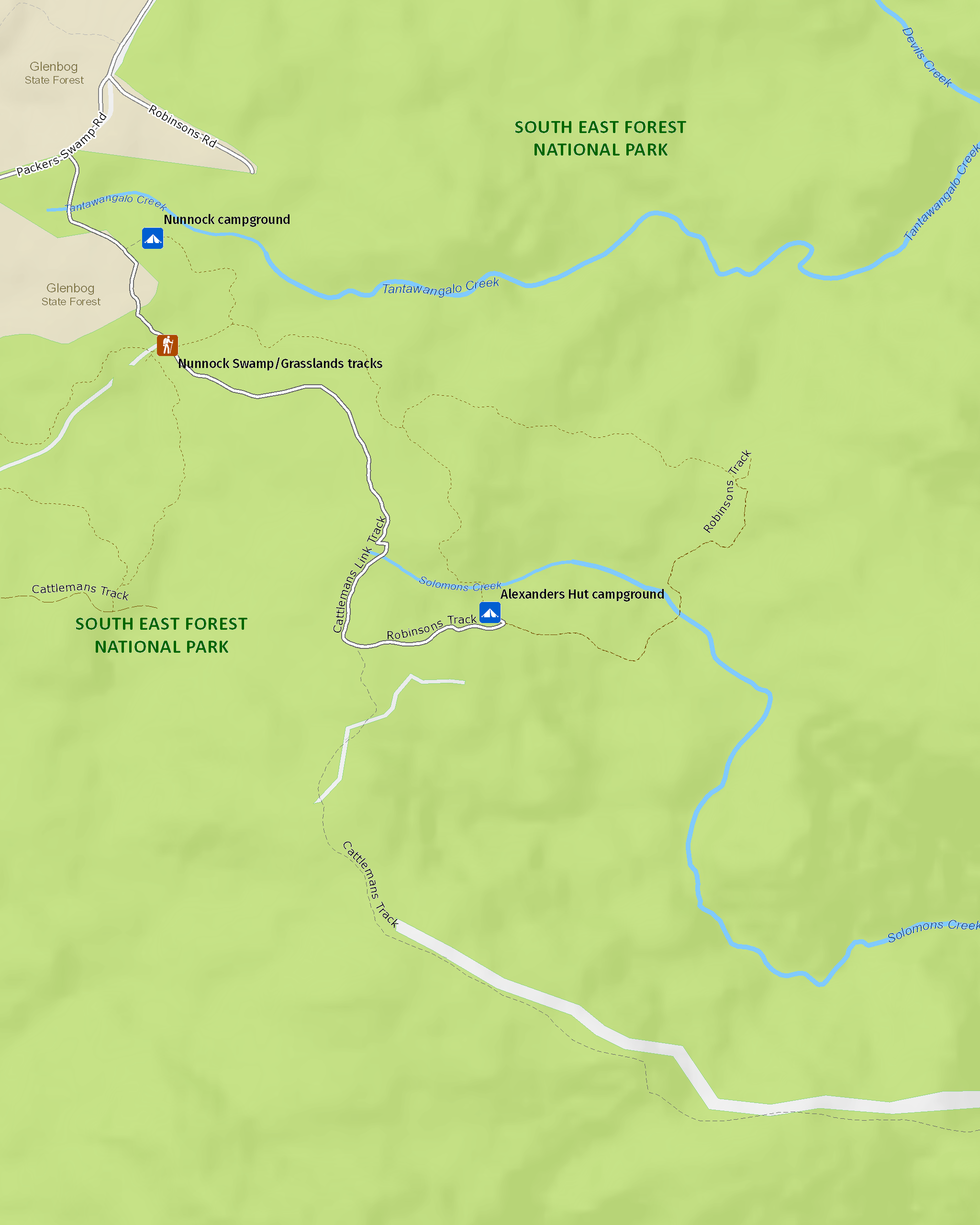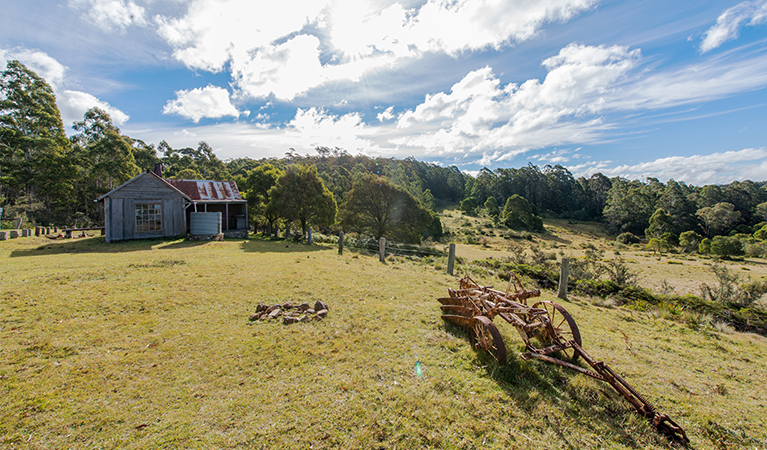Overview
With just 1 campsite, Alexanders Hut campground offers peaceful seclusion in South East Forest National Park—near Bombala. Base yourself here for picnicking, bird watching, walking, horse riding and 4WD adventures.
| Number of campsites | 1 |
|---|---|
| Camping type | Tent, Camper trailer site, Camping beside my vehicle |
| Facilities | Toilets, unpowered sites, marked sites, barbecue facilities, picnic tables |
| Price | There are no camping fees at this campground but a $6 booking fee applies. |
| Bookings | Book up to 6 people or 1 site online. |
| Group bookings | School groups and Park Eco Pass holders can make a group booking enquiry. |
| Please note |
|
Set at the forest edge on a plain of naturally treeless frost hollows, this tranquil spot is the perfect Far South Coast getaway for a family.
Pitch your tent or set up your camper trailer on the grassy area next to Alexanders Hut, then discover this historic cabin, built for yesteryear’s cattleman.
There's plenty more to do nearby. The whole family will enjoy exploring Nunnock Swamp and Grasslands walking tracks to visit nearby Nunnock campground and beyond. Spring and summer bring beautiful wildflower displays along this well marked 15km trail network.
Don't miss the 4km trail around Nunnock Swamp. Surrounded by diverse trees and grasses, this upland swamp hosts many rare and threatened animals, from frogs to a multitude of birds. This area has also been important to Aboriginal people for at least 20,000 years—traditionally a source of food, medicine and fibre.
You can retrace more recent pastoral history at Keys Yards, the remnants of a stock yard, or walk Cattleman's track (2.5km) which is part of a rugged stock route from Monaro to the coast.
Enjoy a meal by your campfire as night falls and keep an eye out for ring-tailed possums and wombats. If you're lucky you may see a greater glider, a very fluffy cat-sized member of the possum family.
Map

Map legend

Local alerts
For the latest updates on fires, closures and other alerts in this area, see https://www.nationalparks.nsw.gov.au/camping-and-accommodation/campgrounds/alexanders-hut-campground/local-alerts
Bookings
- National Parks Contact Centre
- 7am to 7pm daily
- 1300 072 757 (13000 PARKS) for the cost of a local call within Australia excluding mobiles
- parks.info@environment.nsw.gov.au
Operated by
- Bombala office
- Monday to Friday, 8.30am to 4pm.
- 02 6458 5900
- npws.sapphirecoast@environment.nsw.gov.au
- 153 Maybe Street, Bombala NSW 2632
Park info
- in South East Forest National Park in the South Coast and Snowy Mountains regions
South East Forest National Park is always open but may have to close at times due to poor weather or fire danger.
Visitor info
All the practical information you need to know about Alexanders Hut campground.
Getting there and parking
Alexanders Hut campground is in the Tantawangalo area of South East Forest National Park.
To get there from Nimmitabel:
- Drive south for 10km along Snowy Mountains Highway
- Turn right onto Monaro Highway and follow for 4 km
- Turn left onto New Line Road and follow for 19km
- Turn left onto Packers Swamp Road and follow the brown and white signs to Alexanders Hut.
To get there From Bombala:
- Drive east for 19km along Mount Darragh Road
- Turn left onto Tantawangalo Mountain Road and follow the brown and white signs to Alexanders Hut.
Road quality
- Unsealed roads
Vehicle access
- 2WD vehicles
Weather restrictions
- 4WD required in wet weather
Parking
Parking is available next to the campsite.
Facilities
- You’ll need to bring your own supply of drinking and cooking water.
- There are no bins at Alexanders Hut campground so you’ll need to take all rubbish away with you.
Toilets
- Non-flush toilets
Types of sites
- Unpowered sites
- Marked sites
Barbecue facilities
- Fire rings (bring your own firewood)
Picnic tables
Maps and downloads
Accessibility
Disability access level - hard
Wheelchairs can access this area with some difficulty.
Hard access is via steps or a steep slope, or you'll have to move across a rough surface with obstacles such as potholes, tree roots, and rocks. Assistance will be necessary.
Permitted
Camp fires and solid fuel burners
Horses
Camping with horses is allowed at this campground if you have a permit. To get a permit, contact the Bombala office. Please read the code of practice for horse riding in parks before you set out.
Prohibited
Recreational hunting in NSW National Parks is an illegal activity and is a fineable offence.
Gathering firewood
Generators
Pets
Pets and domestic animals (other than certified assistance animals) are not permitted. Find out which regional parks allow dog walking and see the pets in parks policy for more information.
Smoking
NSW national parks are no smoking areas.
Learn more
Alexanders Hut campground is in South East Forest National Park. Here are just some of the reasons why this park is special:
Ancient connections

South East Forest National Park is part of the traditional country of the Yuin People, who had a diverse economy and cultural links with neighbouring Aboriginal clans and tribes. South East Forest National Park and the surrounding area provided a diverse food source of animals and fish, a rich resource for weapon and tool construction, as well as a source of medicines and transport. The park protects a number of Aboriginal sites and remains an important landscape for Aboriginal people today.
Old-growth

In the early 19th century, explorers, miners, squatters and timber getters led the way into the area that is now South East Forest National Park. The forests within the park were utilised as resources for many years up until the 1980's when their transition to national park commenced. The old-growth forest contains eucalypt trees in their final cycle of growth; trees that provide many different types of nest or home sites for wildlife. Some animals, like large forest owls and glider possums depend on these forests for hollows that develop over long periods of time. Pipers lookout in the northern part of the park is a good place to see old growth forests. Take the short loop walk to see magnificent views of Bemboka and the Bega Valley below, and walk through towering old growth forest.
Rock on

South East Forest National Park protects unique physical features that are sure to appeal to budding geologists, keen photographers and nature-lovers alike. The huge granite tors at Pheasants Peak are the result of volcanic activity and millions of years of weathering and erosion. For a close up view, take the challenging Pheasants Peak walk, you'll also be rewarded with stunning views towards the Snowy Mountains and down the south coast escarpment. Don't miss the elliptically shaped Jingera complex at Jingera Rock near the town of Wyndham; a sheer syenite rockface that is the first reported complex of its type in Australia.
- Goodenia Rainforest picnic area Combine a barbecue with birdwatching at Goodenia Rainforest picnic area, near Merimbula. The easy Goodenia Rainforest walk starts from this scenic picnic area.
- Myanba Gorge walking track Myanba Gorge walking track is a short walk near Bombala with wheelchair-friendly access to the first lookout. It’s great spot for birdwatching and an idyllic place for a picnic.
- Nunnock Swamp and Grasslands walking tracks Go to South East Forest National Park near both Nimmitabel and Bombala for a day walk through the Far South Coast hinterland. Go birdwatching or camping at Alexanders Hut.
- Pipers lookout A good place to stop for a picnic, but Pipers lookout in South East Forest National Park also features stunning views – take the easy boardwalk to see for yourself.
Wildlife haven

Koalas, powerful owls and giant burrowing frogs are among the threatened species protected within South East Forest National Park. The park also shelters the state's only known populations of endangered long-footed potoroos. Head to White Rock picnic area and look for small conical pits in the ground - evidence of a potoroo's night-time search for fungus. If you're camping overnight at Six Mile Creek or Nunnock campgrounds, listen and watch for nocturnal creatures like gliders and possums.
- Goodenia Rainforest picnic area Combine a barbecue with birdwatching at Goodenia Rainforest picnic area, near Merimbula. The easy Goodenia Rainforest walk starts from this scenic picnic area.
- Waalimma picnic area Located near both Bega and Bombala on the NSW south coast, Waalimma picnic area in South East Forest National Park is great for birdwatching, bushwalking and camping.
Plants and animals protected in this park
Animals
-

Koala (Phascolarctos cinereus)
One of the most renowned Australian animals, the tree-dwelling marsupial koala can be found in gum tree forests and woodlands across eastern NSW, Victoria and Queensland, as well as in isolated regions in South Australia. With a vice-like grip, this perhaps most iconic but endangered Australian animal lives in tall eucalypts within a home range of several hectares.
-

Swamp wallaby (Wallabia bicolor)
The swamp wallaby, also known as the black wallaby or black pademelon, lives in the dense understorey of rainforests, woodlands and dry sclerophyll forest along eastern Australia. This unique Australian macropod has a dark black-grey coat with a distinctive light-coloured cheek stripe.
-

Long-nosed bandicoot (Perameles nasuta)
A nocturnal marsupial and one of the smaller Australian native animals, the long-nosed bandicoot is found across eastern Australia. Populations in the Sydney region have dwindled since European settlement, leaving only endangered colonies in inner western Sydney and at North Head, near Manly. The long-nosed bandicoot has grey-brown fur and a pointed snout which it uses to forage for worms and insects.
-

Sugar glider (Petaurus breviceps)
The sugar glider is a tree-dwelling Australian native marsupial, found in tall eucalypt forests and woodlands along eastern NSW. The nocturnal sugar glider feeds on insects and birds, and satisfies its sweet tooth with nectar and pollens.
-

Southern boobook (Ninox novaeseelandiae)
The southern boobook, also known as the mopoke, is the smallest and most common native owl in Australia. With a musical 'boo-book' call that echoes through forests and woodlands, the southern boobook is a great one to look out for while bird watching.

